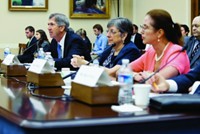Advertisement
Grab your lab coat. Let's get started
Welcome!
Welcome!
Create an account below to get 6 C&EN articles per month, receive newsletters and more - all free.
It seems this is your first time logging in online. Please enter the following information to continue.
As an ACS member you automatically get access to this site. All we need is few more details to create your reading experience.
Not you? Sign in with a different account.
Not you? Sign in with a different account.
ERROR 1
ERROR 1
ERROR 2
ERROR 2
ERROR 2
ERROR 2
ERROR 2
Password and Confirm password must match.
If you have an ACS member number, please enter it here so we can link this account to your membership. (optional)
ERROR 2
ACS values your privacy. By submitting your information, you are gaining access to C&EN and subscribing to our weekly newsletter. We use the information you provide to make your reading experience better, and we will never sell your data to third party members.
Safety
An Obscure Agency Under Fire
Agency for Toxic Substances & Disease Registry favors industry over public health, critics say
by Britt E. Erickson
March 30, 2009
| A version of this story appeared in
Volume 87, Issue 13

ALTHOUGH FEW PEOPLE have ever heard of the Agency for Toxic Substances & Disease Registry (ATSDR), the relatively obscure sister agency of the Centers for Disease Control & Prevention (CDC) has the important mission of preventing disease from exposure to toxic substances in hazardous waste sites. The agency was created in 1980 under the law that set up the Superfund program, which authorizes cleanup of toxic waste sites.
Today, ATSDR finds itself at the center of a congressional investigation, facing repeated criticisms for its willingness to please industry by downplaying the public health effects of exposure to environmental contaminants.
At a hearing of the House Science & Technology Committee's Investigations & Oversight Subcommittee earlier this month, ATSDR Director Howard Frumkin faced questions about the agency's ability to produce high-quality, peer-reviewed health reports based on sound science.
The subcommittee chairman, Brad Miller (D-N.C.), set the tone for the hearing in his opening statement, emphasizing the need for ATSDR's leadership to resist political pressure and insist on scientific integrity. "When federal agencies fail in their mission, the problem is usually a lack of necessary resources," he said. But in this case, he added, "there is no reason to believe that more funding or more staff would result in anything other than a greater volume of jackleg assessments saying 'not to worry.' "
Frumkin, however, responded that ATSDR's problems are due to a lack of resources and staff expertise that it needs to do its job. In fact, the agency's staff has dwindled over the past few years from 500 people to about 300, he noted.
Frumkin emphasized that he is committed to "protecting the public's health and bringing to bear the best science." As an example of this commitment, he pointed out a new initiative between ATSDR and CDC's National Center for Environmental Health (NCEH) called the National Conversation on Public Health & Chemical Exposures. The effort aims to gain external input from a wide range of stakeholders over the next one to two years to help refocus the agency on public health.
But an investigation by the subcommittee calls into question ATSDR's commitment to protecting public health. Started last April, the probe brought to light failures in the agency's assessment of the health hazards of formaldehyde exposures by displaced survivors of Hurricanes Katrina and Rita who were living in trailers provided by the Federal Emergency Management Agency. During the investigation, the subcommittee learned of numerous other incidents in which ATSDR failed to protect communities from exposure to hazardous waste.
These examples are included in a report about the investigation that was released in conjunction with the hearing. The report provides evidence that ATSDR produced a flawed health assessment in Midlothian, Texas, home to three cement plants and one steel mill; downplayed the link between the environment and a polycythemia vera cancer cluster in eastern Pennsylvania, home to seven Superfund sites; provided inadequate studies of asbestos contamination at the Illinois State Beach Park, in Chicago; and minimized the health effects of depleted uranium contamination in Colonie, N.Y., and heavy metal contamination in Vieques, P.R.
"Time and time again ATSDR appears to avoid clearly and directly confronting the most obvious toxic culprits that harm the health of local communities throughout the nation," the subcommittee staff wrote in the report. "Instead, they deny, delay, minimize, trivialize or ignore legitimate concerns and health considerations of local communities and well respected scientists and medical professionals."
IN ADDITION to the flawed assessments, the subcommittee also expressed concern that the agency's reports are not generally peer reviewed. To fix this, Miller suggested that future legislation could require scientific peer review of all ATSDR health assessments. "The vast majority of ATSDR's health reports do not go through independent review today," Miller noted. To allow time for proper review, he recommended that ATSDR take on fewer in-depth projects. He also encouraged the Obama Administration to take a hard look at the agency. Some lawmakers suggested combining ATSDR and NCEH, both of which Frumkin directs.
In response to the peer review question, Frumkin said that ATSDR uses an algorithm that balances the need to get an assessment out quickly and the need for good science. The agency works hard to accelerate the production of its reports, so most are not routinely peer reviewed, he said.
Frumkin defended ATSDR, saying that the agency has an intrinsically difficult mission. "There are thousands of hazardous waste sites," he noted. ATSDR issues hundreds of health assessments each year, he added, and has a "strong track record of sticking to the science and advancing public health, even in sometimes controversial, highly charged situations."





Join the conversation
Contact the reporter
Submit a Letter to the Editor for publication
Engage with us on Twitter